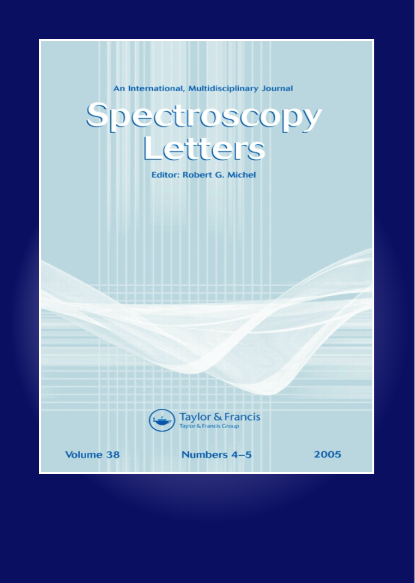土耳其南部菊科、Fabaceae和Lamiaceae科一些药用植物中植物矿物质营养素和潜在有毒元素的浓度:对健康影响的见解
IF 1.6
4区 化学
Q3 SPECTROSCOPY
引用次数: 0
摘要
摘要药用植物在历史上一直被用于治疗安纳托利亚传统民间医学以及世界各地的许多疾病。由于世界各地人口的增加,农业和工业活动迅速增加,导致空气、水和土壤污染,并在药用植物中积累潜在的有毒元素。本研究对38种重要药用植物进行了矿质营养成分和潜在毒性元素分析,这些植物分别隶属于菊科、豆科和Lamiaceae。钙的常量元素百分比(以%计)在0.20和1.46之间变化,钾的百分比在0.08和1.35之间变化,镁的百分比在0.04和0.24之间,钠的百分比在0.01和0.34之间变化,而铝的微量元素和潜在有毒元素浓度(以mg kg−1计)在3.21和721.28之间变化,硼的百分比在41.33和231.01之间变化,镉的百分比在0.01%和0.61之间变化,铬的百分比在1.09和47.79之间变化,铜分别为12.90和43.13,铁分别为17.75和1109.39,锰分别为51.50和715.48,镍分别为0.12和9.42,铅分别为1.58和22.11,锌分别为80.82和260.08。此外,还计算了潜在有毒元素的估计日摄入量(EDI)、目标危险系数(THQ)和危险指数(HI),以及矿物质营养素的推荐膳食摄入量(RDA)值。在工业和采矿地区的一些样本中,一些潜在有毒元素的积累略高于世界卫生组织(世界卫生组织)规定的允许限度。总之,从山区农村地区、远离采矿、靠近清洁河流等保护区收集药用植物的重要性,以及通过对人类健康的潜在有毒元素分析定期控制价值的重要性,再次得到了理解。本文章由计算机程序翻译,如有差异,请以英文原文为准。
Concentrations of plant mineral nutrients and potentially toxic elements in some medicinal plants in the Asteraceae, Fabaceae, and Lamiaceae families from Southern Türkiye: insights into health implications
Abstract Medicinal plants have been used throughout history in the treatment of many diseases in traditional Anatolian folk medicine as well as all over the world. The rapid increase in agricultural and industrial activities due to the increasing population around the world causes air, water and soil pollution, and accumulation of potentially toxic elements in medicinal plants. In this study, plant mineral nutrients and potentially toxic elements analyzes were carried out in 38 plant species belonging to the medicinally important families Asteraceae, Fabaceae and Lamiaceae. The percentage of macroelements (in %) varies between 0.20 and 1.46 for calcium, 0.08 and 1.35 for potassium, 0.04 and 0.24 for magnesium, 0.01 and 0.34 for sodium, while concentrations of microelements and potentially toxic elements (in mg kg−1) vary between 3.21 and 721.28 for aluminum, 41.33 and 231.01 for boron, 0.01 and 0.61 for cadmium, 1.09 and 47.79 for chromium, 12.90 and 43.13 for copper, 17.75 and 1109.39 for iron, 51.50 and 715.48 for manganese, 0.12 and 9.42 for nickel, 1.58 and 22.11 for lead and finally 80.82 and 260.08 for zinc. In addition, estimated daily intake (EDI), target hazard quotient (THQ), and hazard index (HI) for potentially toxic elements, and Recommended Dietary Allowance (RDA) values for mineral nutrients were calculated. In some samples in industrial and mining areas, accumulation of some potentially toxic elements was slightly above the permissible limits set by the World Health Organization (WHO). In Summary, the importance of collecting medicinal plants from protected areas such as mountainous rural areas, far from mining, close to clean rivers, and regular control of values with potentially toxic elements analyzes for human health has been understood once again.
求助全文
通过发布文献求助,成功后即可免费获取论文全文。
去求助
来源期刊

Spectroscopy Letters
物理-光谱学
CiteScore
2.90
自引率
5.90%
发文量
50
审稿时长
1.3 months
期刊介绍:
Spectroscopy Letters provides vital coverage of all types of spectroscopy across all the disciplines where they are used—including novel work in fundamental spectroscopy, applications, diagnostics and instrumentation. The audience is intended to be all practicing spectroscopists across all scientific (and some engineering) disciplines, including: physics, chemistry, biology, instrumentation science, and pharmaceutical science.
 求助内容:
求助内容: 应助结果提醒方式:
应助结果提醒方式:


